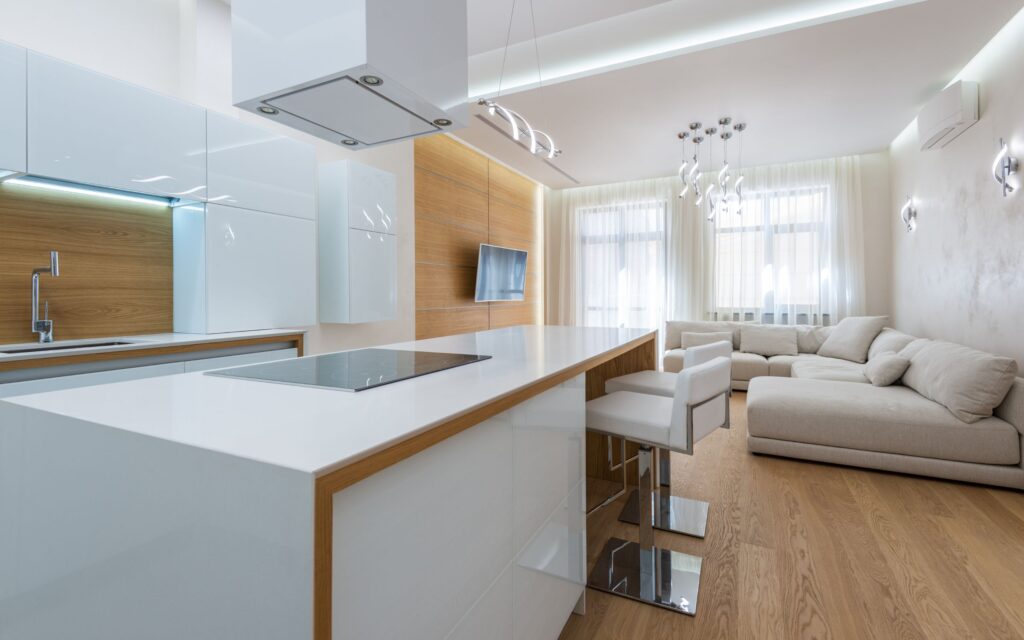Selecting the perfect countertop color to complement your kitchen design involves carefully considering factors like cabinetry, flooring, lighting, and room size. The array of countertop materials and hues available today provides plenty of beautiful options.
Visit local countertop stores to view samples in person. See how the colors change at different times of day. Natural and artificial light affects how we perceive tones and textures. Spend time looking so you choose a shade that always looks its best. Follow these tips when evaluating countertop colors for your kitchen:
Complement Existing Elements
The starting point involves assessing your existing kitchen layout, features, and color scheme.
What tone and style of cabinetry will your new countertops accompany? Do you want to match or contrast the counters with floor materials? Will the space feature warm, bright lighting or more subtle ambient fixtures? How do you want homeowners and visitors to experience the overall mood?
Answers to these questions help narrow suitable countertop hues that will integrate harmoniously rather than clash. A one-color countertop that perfectly complements oak cabinetry might overwhelm against crisp white cupboards. The goal is a holistic kitchen design where no single element distracts or feels out of sync.
When selecting a kitchen countertop color, be sure to:
- View large samples in the actual kitchen space under typical lighting conditions.
- Analyze colors at different times of day as natural and artificial light impacts perceptions.
- Pay attention to undertones that may appear more/less prominent alongside existing finishes.
- Consider how the finishes of surrounding materials (e.g. matte paint vs. glossy tile) impact aesthetics
This diligence results in a search for the right aesthetic alignment.
Lighter vs. Darker Countertop Colors
Beyond coordinating with existing kitchen elements, the room’s size and natural light levels help dictate light versus traditional dark countertop colors.
Light Kitchen Countertop Colors
Lighter countertop shades like white, cream, light gray, and beige reflect light well, helping kitchens feel open and airy. They create the illusion and feeling of more space and work especially well in smaller kitchens or rooms with limited natural light. Just note that lighter counters require more frequent cleaning to keep surfaces free of visible dust and spills.
Consider lighter hues with these kitchen attributes:
- Smaller square footage
- Northern or limited exposures restricting natural light
- Cabinets/walls are finished in lighter wood tones or painted colors.
- Lighter floors such as oak or birch wood
- Desire for a contemporary, preppy, or rustic chic aesthetic
Popular lighter color choices – white, cream, light gray, tan, light brown
Dark Kitchen Countertops
On the other end of the spectrum, darker grays, browns, blacks, and colors like navy blue make smart choices for larger kitchens with plentiful light. The striking visual contrast against white cabinets and light walls and floors energizes these expansive spaces. Darker counters also disguise messy fingerprints and light debris compared to lighter materials.
Consider richer hues with these kitchen qualities:
- Larger square footage
- Southern or multiple exposures allow abundant natural light.
- Cabinets/walls featuring darker stains or bold paint colors
- Darker floors e.g. walnut or dark laminates
- Desire for an elegant, dramatic, or Old World aesthetic
Popular dark color choices – black, dark gray, rich navy blue, dark brown, exotic granite patterns
Matching Countertops to Painted Cabinets
Paint offers almost endless options for customizing white countertops and kitchen cabinetry to match any color scheme. So what about coordinating counters against an energizing teal, muted gray, or even black backdrop?
The eclectic nature of painted cabinets provides exciting yet potentially nerve-wracking latitude when selecting companion surfaces. Essentially no limits exist beyond personal vision and nature’s pigment offerings. But restraint still serves most cohesive kitchen designs.
Factors Impacting Perceived Color
While your initial reaction steers toward lighter tones or darker counters, also consider how surrounding materials influence the actual tone perceived.
For example, natural lighting at different times of day interacts with undertones to make some colors appear lighter or more subdued. Soft white paint alongside bright white quartz counters may lend a creamier cast. Small kitchens dressed mostly in light woods visually expand lighter counters so they don’t appear stark.
Like a gradually changing mood ring, kitchen countertops morph in concert with the kitchen canvas. Be attentive to these impacts when previewing countertop sample boards at home.
Kitchen Countertop Options To Choose From
Color availability also often varies across common countertop materials like quartz, granite, marble, laminate, and concrete. Limit or expand your options accordingly.
- Quartz: Offers the widest color range from crisp whites to bold blues in matte to glossy finishes. Branded engineered stones from Cambria, Caesarstone, and Silestone include options emulating marble along with solid hues.
- Granite: Natural stone with gorgeous depth and dimension. Choose from multitudes of exotic styles in neutral creams to bold varietals peppered with rainbow mineral deposits.
- Marble: Elegant Old World aesthetic in creamy vanilla and gray swirling patterns. Requires diligent sealing but lends high-end drama.
- Laminate: Most mimic stone/quartz visuals but limit darker hues to popular colors that show scratches. Durable neutral solids suit contemporary or rustic kitchens.
- Concrete: Offers color integrally mixed throughout the slab and gaining popularity. Light maintenance is the perfect complement for an industrial edge.
- Wood: Feature warm, natural grain patterns ideal for certain aesthetics but require heavy sealing/oiling.
While personal color preference guides selection, analyze the practicalities of coloring and maintaining each material within your lifestyle. A high-traffic kitchen with messy young cooks may value durable quartz ease over marble elegance and warmth.
Countertop Edge Designs
Edge profiles framed against cabinetry/backsplashes provide another opportunity to integrate colors. Contemporary rectangular edges maintain countertop tones viewed from above. Or explore contrasting materials and hues with waterfall edges or inlays featuring wood, metal, or colored glass. This introduces new dimensions to your design.
Key Takeaways
Choosing the right countertop colors involves:
- Carefully examining how tones appear against existing kitchen finishes under typical lighting conditions.
- Determining if light or dark materials best complement room size and exposures
- Considering variation created by natural and artificial lighting interacting with undertones
- Analyzing color palettes available within your preferred countertop materials
- Contemplating if edge designs harmonize or contrast with major surface hues
While personal color preference matters most, utilize professional designer perspectives and your observance of in-home color dynamics before finalizing your wood countertop decisions. This ensures you select both a fetching color and optimal countertop material to satisfactorily anchor your new kitchen for years to enjoy.




